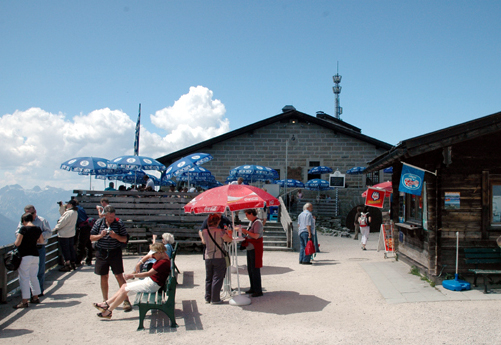|
On April 25, 1945, the British bombed
the Nazi homes on the Obersalzberg, including Hitler's home called
the Berghof. The bombed-out ruins of Hitler's former residence
were completely razed to the ground by the Bavarian government
in 1952 at the request of the U.S. Army.
The Berchtesgaden area was occupied by
American troops shortly before the war ended on May 8, 1945.
The Obersalzberg was turned into a recreational area for the
American troops that occupied Germany after the war. After 50
years of American occupation, the Obersalzberg was given back
to Germany in 1995.
To this day, many Americans are confused
by the names Berghof and Eagle's Nest, which are two separate
places. The Berghof was located on a plateau called the Obersalzberg
which is on the route to the top of the Kehlstein, the mountain
where Hitler's tea house, called the Eagle's Nest, was built
in 1938. To add to the confusion, Hitler had another tea house,
called Mooslahnerkopf, which was a short walk from the Berghof.
The German name for the Eagle's Nest is Kehlsteinhaus, which
means house on Kehlstein mountain.
There are many photographs of Hitler,
Eva Braun and various Nazi officials that were taken on the terrace
at Berghof, but have been mistakenly identified as photos taken
at the Eagles's Nest.
In the photo below, the terrace at the
Eagle's Nest, covered with blue umbrellas, is shown on the left;
it was added after 1960. On the right is a small building where
one can buy books and souvenirs of the Eagle's Nest. From the
terrace, there is a view of the Königssee on the German
side. On the other side of the Eagle's Nest, there is a view
of Salzburg in Austria.
 Terrace at the Eagle's
Nest was added after 1960
Terrace at the Eagle's
Nest was added after 1960
In 1938, a train station was built at
the small town of Berchtesgaden to handle the hordes of Hitlerpilger
(Hitler pilgrims) who flocked to the Obersalzberg to see Hitler's
home, called the Berghof. Today, tourists arrive at this same
train station in Berchtesgaden on their way to see Hitler's former
Tea House, called the Eagle's Nest by Americans. The drive from
the town of Berchtesgaden to the Obersalzberg plateau at 3,300
feet is one of the most scenic routes in Germany.
Hitler's admirers used to gather at the
Berghof just like the Elvis fans who stood outside Graceland,
hoping to get a glimpse of their idol. The German people literally
worshiped the ground that Hitler walked on. After Hitler made
an occasional appearance to greet his fans, they would gather
up the sand upon which Hitler had stood. Hitler was known as
"the people's Chancellor" because he was a common man,
and he did what the German people wanted. Before World War II
started, Hitler was more loved than any other leader in world
history; his approval rating was 98%. As the man who was responsible
for the deaths of 60 million people, including 6 million Jews,
Hitler has now become the most hated man in the world.
The road from Munich to Berchtesgaden
is the "old Nazi party road," the first Autobahn built
by Hitler to connect Berlin, Nürnberg and Munich with Salzberg
and Linz in Austria. Tour buses from Munich bring visitors to
the Obersalzberg where they get on another bus that takes them
up to the Kehlsteinhaus aka the Eagle's Nest.
The spot where Hitler's Berghof once
stood is now covered by trees and souvenir hunters have picked
the area clean. When I visited in 1997, there was a sign that
warned visitors that this spot was off limits and even photographs
of the wooded area where the Berghof once stood were forbidden.
When I visited again in 2007, I was surprised that the tour guide
pointed out the former location of the Berghof, which is within
sight of the InterContinental hotel on the Obersalzberg.
In 1942, a honeycomb of bunkers was built
into the mountainside at the Obersalzberg for air raid shelters.
One of the largest surviving bunkers is under the documentation
center and it is open to visitors. The saga of Hitler, the Obersalzberg
and Berchtesgaden is told at the documentation center, called
Dokumentation Obersalzberg, which opened in 1999. Dokumentation
Obersalzberg tells how Hitler first visited the Obersalzberg
in 1923 and was inspired by views of the Untersberg, the mountain
where the spirit of Karl der Grosse (Charlemagne) is said to
slumber. Karl der Grosse was the King of the Franks who was crowned
as the first Emperor of the Holy Roman Empire on Christmas day
in the year 800. This was the first time that the German people
were united under one ruler, although the Holy Roman Empire included
other ethnic groups.
Hitler's great accomplishment was that
he united the German ethnic group into one empire under one leader
for the first time: "ein Folk, ein Reich, ein Führer."
This was achieved by annexing Austria and the Sudetenland in
1938. The famous conference in which the Sudetenland was given
to Germany in October 1938 was held at the Berghof. Ethnic Germans
in the Baltic countries of Estonia, Latvia and Lithuania were
relocated to the part of Poland that was annexed into the Greater
German Reich in 1939. Finally, with the conquest of France in
1940, the provinces of Alsace and Lorraine were added to the
Greater German Reich.
|